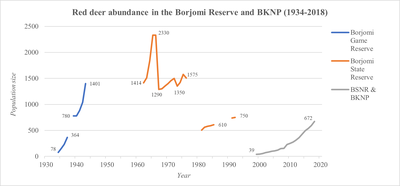Assessing the effectiveness of protected areas in preserving wildlife amidst socio-economic and political shocks: A case study of protected areas in the South Caucasus
Irina Kirsanova
Protected areas are key biodiversity conservation tools. However, their effectiveness is disputable, since biodiversity loss persists despite the growing number of protected areas worldwide. For developing countries, effectiveness of protected areas is critical, as their performance is often compromised through abrupt socio-economic and political changes (“shocks”). This thesis investigates effects that shocks related to the dissolution of the USSR in 1991 produced on management performance and wildlife abundance in the protected areas of the South Caucasus. It uses an example of the Borjomi-Kharagauli National Park and the Borjomi Strict Nature Reserve in Georgia, and the Khosrov Forest State Reserve in Armenia, focusing on the abundance of ungulate as a key metric to evaluate ecological outcomes of protected areas. It combines, management, ecological, and contextual approaches towards performance of protected areas and aims to contribute to a better understanding of protected areas effectiveness in the South Caucasus, one of the most diverse and vulnerable regions on Earth. Finding of this thesis suggest that shocks caused a considerable decline in the abundance of ungulates in the selected protected areas during the first decade after the collapse of the USSR, mainly due to poaching. In the 2000s, this trend reversed. This change is associated primarily with increased financing and improved human and technical capacities of protected areas. In a broader context, positive trends of wildlife abundance match with positive economic development trends measured with GDP. Considering importance of sustainable financing and capacities to the positive ecological outcomes of protected areas, it is recommended to take efforts to secure their sustainability.


Fig. 2: Bezoar goat abundance in Armenia (1970s-2019) according to Gasparyan (1974), Ayrumyan and Gasparyan (1976), Weinberg and Malkhasyan (2010) and WWF Armenia (2020)
